
Edward Winter
Three games involving the little-known player Soldatenkov were given in 1000 Best Short Games of Chess by I. Chernev (New York, 1955): victories against an anonymous player and F.J. Marshall (in 17 and 21 moves respectively and both published on page 433 of the November 1928 BCM) and The Consultation Game That Never Was. Another brilliancy is on pages 43-44 of Kings, Commoners and Knaves:
Vassily Soldatenkov – N.N.
Occasion?
Ruy López
1 e4 e5 2 Nf3 Nc6 3 Bb5 Nf6 4 d3 d6 5 Be3 Bd7 6 Nbd2 d5 7 exd5 Nxd5 8 Qe2 Bd6 9 Ne4 Bg4 10 O-O-O O-O 11 h3 Bh5 12 g4 Bg6 13 h4 h5 14 Nfg5 hxg4 15 h5 Bxe4 16 Nxe4 f5 17 Bc4 Ne7 18 Bg5 c6

19 h6 g6 20 h7+ Kh8 21 Bh6 fxe4 22 dxe4 Rf7 23 Qxg4 Nf6 24 Qg5 Ned5 25 exd5 cxd5 26 Qxg6 Qc7 27 Bxd5 Nxd5
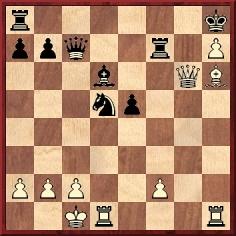
28 Qg8+ Rxg8 29 hxg8(Q)+ Kxg8 30 Rdg1+ Rg7 31 Rxg7+ Qxg7 32 Bxg7 Kxg7

33 Rd1 and wins.
Source: The Times Literary Supplement, 24 October 1902, page 320.
When we published this game in the BCM in 1975 we commented:How famous would the following game have become had it been played by Morphy?
See pages 43-44 of Kings, Commoners and Knaves.
Below are some further neglected games:
Vassily Soldatenkov – Fürst G.1 e4 e5 2 d4 Nc6 3 dxe5 Nxe5 4 f4 Ng6 5 Nf3 Bb4+ 6 c3 Ba5 7 Bc4 N8e7 8 f5 Nf8 9 Bxf7+ Kxf7 10 Ne5+ Ke8 11 Qh5+ g6
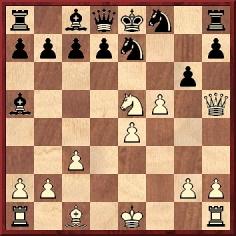
12 f6 Ne6 13 f7+ Kf8 14 Bh6+ Ng7 15 Qh4 Nc6 16 Bg5 Ne7 17 Rf1 d6 18 Bxe7+ Qxe7 19 Nxg6+ hxg6 20 Qxh8 mate.
Source: Deutsche Schachzeitung, July 1902, pages 215-216.
Vassily Soldatenkov – A.J. Barasov1 e4 e6 2 Qe2 Nf6 3 f4 Bc5 4 Nf3 O-O 5 d4 Bb6 6 e5 Nd5 7 c4 Ba5+ 8 Kf2 Ne7 9 Nc3 c6 10 g4 d6 11 Be3 dxe5 12 dxe5 Bb6 13 Rd1 Bxe3+ 14 Qxe3 Qb6 15 c5 Qxb2+ 16 Rd2 Qb4 17 Bd3 Nd5 18 Nxd5 exd5 19 Rb1 Qa5
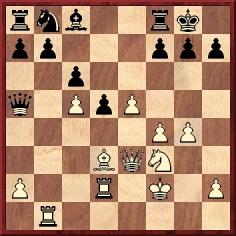
20 Bxh7+ Kxh7 21 Ng5+ Kg8 22 Qd3 f5 23 Qh3 Qxd2+ 24 Kg1 Re8 25 Qh7+ Kf8 26 Qh8+ Ke7 27 Qxg7+ Kd8 28 Qf6+ Re7 29 Nf7+ Ke8 30 Nd6+ Kd7 31 Qxf5+ Re6 32 Qf7+ Re7 33 e6+ Kc7 34 Qxe7+ Nd7

35 Qxd7+ Bxd7 36 Rxb7+ Kd8 37 Rxd7 mate.
Source: Page 171 of Traité du jeu des échecs by J.
Taubenhaus (Paris, 1910). Brief notes by Soldatenkov were
included.
1 d4 d5 2 Nf3 Nf6 3 c4 e6 4 Nc3 dxc4 5 Bg5 Be7 6 e3 Nd5 7 Bxe7 Nxc3 8 bxc3 Qxe7 9 Bxc4 O-O 10 O-O b6 11 Bd3 Nd7 12 Qc2 g6 13 Be4 Rb8 14 Qa4 a5 15 Bc6 Rd8 16 Rfd1 Bb7 17 Bxb7 Rxb7 18 Qc6 Ra7 19 Rab1 Qd6 20 Qe4 Nf6 21 Qh4 Qe7 22 e4 Kg7 23 Rb5 c6 24 Rxb6 Qc5
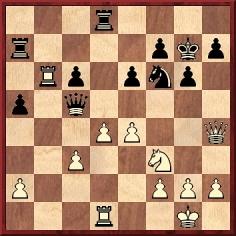
25 e5 Qxb6 26 exf6+ Kf8 27 Qxh7 Ke8 28 Ne5 Qc5 29 Qg8+ Qf8 30 Qxf8+ Kxf8 31 Nxc6 Resigns.
Source: La Stratégie, January 1912, pages 23-25. The game was annotated by ‘A.G.’, who concluded:
‘La partie a été un peu légèrement jouée par le jeune champion de la Régence et ne donne pas la mesure de sa force. Par contre, le brillant amateur russe l’a conduite avec une précision et une logique impeccables. Nous considérons Mr Soldatenkoff comme un des plus forts joueurs de Paris. Personne n’a plus de science ni de brio.’
From page 224 of the American Chess Bulletin, November 1917 (an item headed ‘Ending between Russian Diplomats’):

A computer check shows that White missed a number of faster wins.
Soldatenkov’s name became associated with 1 e4 e5 2 f4 Bc5 3 Nf3 d6 4 fxe5 (the ‘Soldatenkov Attack’ or ‘Soldatenkov Variation’) after the following appeared on page 124 of the Carlsbad, 1907 tournament book by Marco and Schlechter:
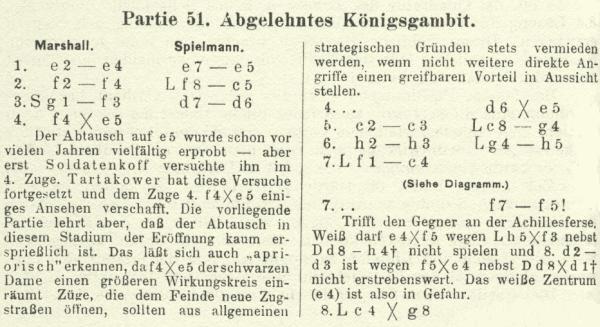
A number of Soldatenkov’s early games in Russia, together with much other material, were given in a small monograph on him, Tajemný Námořník by V. Čarušin (Brno, 1998). The New York Times (15 October 1917, page 16) reported that a Marshall/Soldatenkov v Janowsky/Jaffe consultation game had just begun (‘The contest will probably extend over the greater part of the week. Marshall and Soldatenkov, playing the white pieces, elected a queen’s pawn opening, to which the rival pair replied with knight to king’s bishop third.’). Further information would be welcome. Page 210 of the December 1921 American Chess Bulletin gave the score of an 18-move draw by Soldatenkov against Perkins which was played in a Metropolitan League match between the Marshall Chess Club and the Brooklyn Chess Club. A loss by Soldatenkov to Zirn in the Metropolitan Chess League was published on page 25 of the February 1922 American Chess Bulletin. More details are sought about the game ending ‘Soldatenkov-Wolf, Berlin, 1925’ given on pages 119-120 of The Joys of Chess by F. Reinfeld (New York, 1961). Soldatenkov’s 21-move victory over Marshall referred to at the beginning of the present item was published by H. Wolf on pages 300-301 of the September-October 1928 issue of Kagans Neueste Schachnachrichten. Clarification of the circumstances of the game, together with notes by Soldatenkov himself, appeared on pages 197-200 of the June 1929 issue. A lengthy article by Soldatenkov was published on pages 221-226 of the July 1929 Kagans Neueste Schachnachrichten. It discussed a recent victory over A. Zimine in the light of a Bogoljubow v Euwe game (the seventh contest in their second match, played in Amsterdam on 2 January 1929 – see pages 53-54 of the February 1929 Wiener Schachzeitung).
Below is page 109 of the revised edition of Mitchell’s Guide to the Game of Chess by David A. Mitchell (Philadelphia, 1920):
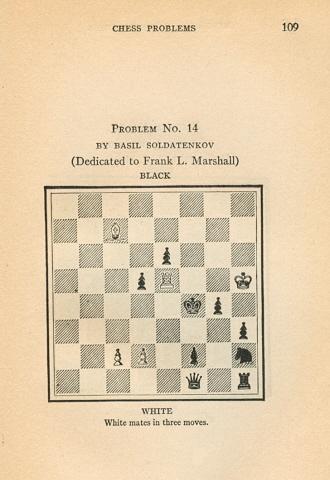
Soldatenkov also has a bearing on the origins of the Marshall Gambit in the Ruy López. At New York, 1918 Marshall played 8...d5 twice, against Capablanca and Morrison. Regarding the latter game it was pointed out on page 276 of the December 1918 American Chess Bulletin (under the heading ‘Duplication of Game after 17 Years’) and on page 21 of the tournament book that a game Sittenfeld v Soldatenkov, Paris, 1901 had followed Morrison v Marshall as far as move 18 (when Soldatenkov played ...Bd6 instead of ...gxf6). Whereas Marshall’s victory took 84 moves, Soldatenkov won in 25.
Without reference to these American sources, the Sittenfeld v Soldatenkov game was given by Kevin O’Connell on page 186 of the April 1980 BCM (in K. Whyld’s ‘Quotes & Queries’ column). It was stated that O’Connell had found the game in La Stratégie for 1901, but we do not see it there.
On pages 314-315 of the July 1987 BCM we quoted from, and commented on, the above-mentioned American Chess Bulletin item. Page 612 of the November 1999 BCM (also in the ‘Quotes & Queries’ column) referred to the difficulty in finding biographical information about Soldatenkov (whose birth details were given as 14 July 1879 at Tsarskoye Selo – as mentioned on page 3 of the booklet on Soldatenkov by Čarušin/Charushin).
The lack of information about Soldatenkov (e.g. where and when he died) is particularly strange in view of his prominence as a diplomat on both sides of the Atlantic. A lengthy political article on page 12 of the New York Times, 20 October 1918 included the following:
‘Basil Soldatenkov, standing six feet in his socks and as hard as nails, his deep-set gray eyes looking you straight through from beneath the ledge of a massive brow crowned with waving light brown hair, is a comparatively young man to have had the experiences and to have shouldered the responsibilities which have been his.
He is, perhaps, five and thirty, and by natural mental inclination a mathematician and electrical engineer. On leaving the university, it was his intention to make scientific research his life work, but circumstances led him, first, to try for and win a commission in the Russian navy, and later to enter the Russian Diplomatic Corps.
Mr Soldatenkov served the Imperial Russian Government in nearly every capital of Europe. There are few men living who have as intimate a personal acquaintance with the great diplomats of the world. He came to this country on a special mission from the Kerensky Government.’
It will be noted that his forename was given as ‘Basil’, i.e. the anglicized version of Vassily. However, page 63 of the March 1918 American Chess Bulletin referred to ‘Boris Soldatenkoff, the Russian envoy’. Because of German transliteration, the initial of his forename was sometimes recorded as W (‘Wassily’). The index for the 1907 volume of Deutsches Wochenschach (page 483) had ‘Soldatenkow, W.W. (St Petersburg)’.
Below is an extract from the New York Times, 18 March 1920, page 11:
‘Mr and Mrs Basil Soldatenkov yesterday surprised their relatives and friends by announcing they had been married in Newark, NJ on Tuesday. Mrs Soldatenkov was formerly Miss Madeleine Reese, niece of Martin Vogel, Assistant United States Treasurer, and Mrs Vogel, with whom she had resided since the death of her mother six years ago.
Mr Soldatenkov, who was a special envoy of the provisional Government of Russia, had been attentive to Miss Reese for some time, but Mr and Mrs Vogel withheld their consent to the marriage, owing chiefly to the disparity of their ages, their niece being only 20 years of age and Mr Soldatenkov about 17 years her senior ...
Mr Soldatenkov has been married before. His first wife was the Princess Gotchakoff of Russia, from whom he was divorced last November.
Mr Soldatenkov was Under Secretary of State in Russia under the Milyoukof régime. He met and took charge of Elihu Root and the American Mission when it arrived in Russia, and returned here with the Mission. On his arrival he was thanked personally by President Wilson and Mr Root and was presented with a cigarette case bearing an inscription in acknowledgement of his services to the American Mission.’
The above two references to Soldatenkov in the New York Times suggest that he was born in or around 1883. It was subsequently reported by the newspaper (21 December 1928, page 13, and 11 October 1933, page 27) that the couple were divorced in Nice in October 1928. On 10 October 1933 the marriage took place in London between Madeleine Soldatenkov and ‘Baron Constantine Nicolai Stackelberg, whose father, Baron Nicolai Stackelberg, was a master of ceremonies at the court of the late Czar Nicholas of Russia’.
The Family Search website produces the information that ‘Vasilij Vassilievich Soldatenkov’ was born circa 1869 in ‘Tachanj, Pltv, Ukraine’ and that he married ‘Elena Konstantinovna, Princess Gorchakov’ on 20 January 1901. However, there is also an entry for ‘Basil Soldatenkow’, born in Moscow on 14 June 1877.
The search for biographical details about Soldatenkov continues, and for the time being we conclude with a quiz question arising from one of his early games:
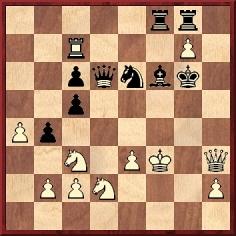
White to move. What is the fastest win?
(6138)
Vitaliy Yurchenko (Uhta, Komi, Russian Federation) reports that page 43 of the Russian edition of the monograph by V. Charushin (Omsk, 2000) reproduced Soldatenkov’s Полный послужной список (complete service record), dated 13 January 1913. It gave his birth-date as 14 July 1879 (old style).
We have found a passage about Soldatenkov on page 99 of Self Portrait by Man Ray (Boston and Toronto, 1963). Elsa Schiaparelli has just been mentioned.
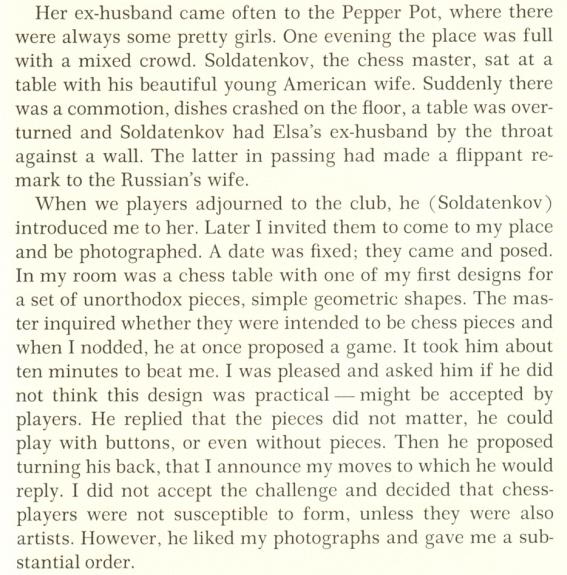
Page 243 reproduced the well-known (indoor) photograph of Man Ray playing chess with Marcel Duchamp (Paris, 1956).
(6144)

This position (White to move) at the end of C.N. 6138 came from page 52 of the 15 February 1898 issue of La Stratégie, which stated that White (Soldatenkov) gave mate in eight moves. The solution on page 119 of the 15 April 1898 magazine was 1 Qh7+ Kxh7 2 gxf8(N)+ Kh6 3 Rh7+ Kg5 4 h4+ Kf5 5 e4+ Ke5 6 Nc4+ Kd4 7 Ne2+ Kxc4 8 b3 mate.
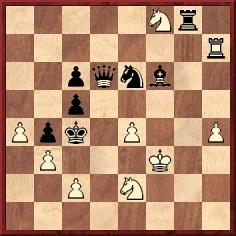
However, it was also pointed out by La Stratégie that two correspondents (Guinet and Buckley) had offered a quicker finish (4 Nde4+ Kf5 5 Nxd6+ Ke5 6 Nf7+ Kf5 7 e4 mate).
When the initial position was given on page 16 of the Czech edition of V. Charushin’s booklet on Soldatenkov (the source being specified as Shakhmatny Zhurnal, 1897, page 357) Black had two additional pieces: a knight on b7 and a bishop on c4. There is then no mate in seven, and the fastest mate is the above line ending in 8 b3.
(6145)
Vitaliy Yurchenko (Uhta, Komi, Russian Federation) supplies the text in the Russian edition of the monograph on Soldatenkov by V. Charushin (Omsk, 2000):
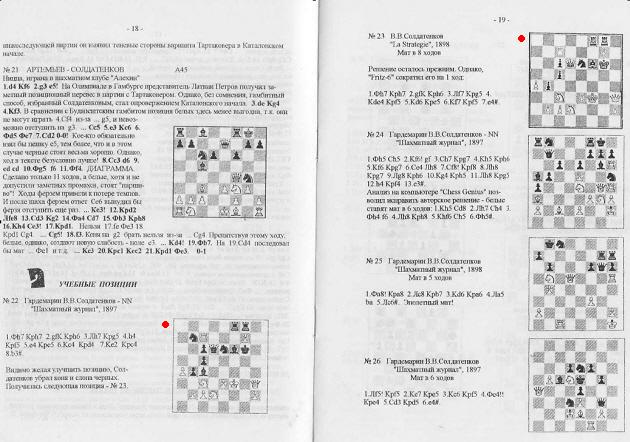
(6187)
C.N. 6138 (see above) included the following information:
Soldatenkov also has a bearing on the origins of the Marshall Gambit in the Ruy López. At New York, 1918 Marshall played 8...d5 twice, against Capablanca and Morrison. Regarding the latter game it was pointed out on page 276 of the December 1918 American Chess Bulletin (under the heading ‘Duplication of Game after 17 Years’) and on page 21 of the tournament book that a game Sittenfeld v Soldatenkov, Paris, 1901 had followed Morrison v Marshall as far as move 18 (when Soldatenkov played ...Bd6 instead of ...gxf6). Whereas Marshall’s victory took 84 moves, Soldatenkov won in 25.
Tony Gillam (Nottingham, England) notes that the Sittenfeld v Soldatenkov game had been published too in the Brooklyn Daily Eagle, 22 November 1918, Section 1, page 2:

Mr Gillam also draws attention to a photograph (Le Mans, 1913) at the Gallica website.
John Hilbert (Amherst, NY, USA) takes up another point in C.N. 6138, where we wrote:
The New York Times (15 October 1917, page 16) reported that a Marshall/Soldatenkov v Janowsky/Jaffe consultation game had just begun (‘The contest will probably extend over the greater part of the week. Marshall and Soldatenkov, playing the white pieces, elected a queen’s pawn opening, to which the rival pair replied with knight to king’s bishop third.’). Further information would be welcome.
Dr Hilbert provides the following from page 15 of the Washington Evening Star, 22 October 1917:

1 d4 Nf6 2 e3 d5 3 Bd3 c5 4 c3 e6 5 f4 Be7 6 Nd2 b6 7 Ngf3 O-O 8 Ng5 Nbd7 9 Qc2 h6
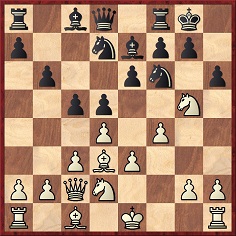
10 h4 Bb7 11 Ndf3 c4 12 Bh7+ Kh8 13 g3 Ne4 14 Qh2 b5 15 Bxe4 dxe4 16 Ng1 b4 17 Ne2 a5 Adjourned.
Whether the game was ever resumed has not been ascertained.
C.N. 6183 also mentioned that page 25 of the February 1922 American Chess Bulletin published a loss by Soldatenkov to Zirn in the Metropolitan Chess League. John Hilbert adds that the score had appeared on page A3 of the Brooklyn Daily Eagle, 23 February 1922:

Soldatenkov v Zirn: 1 d4 d5 2 Nf3 Nf6 3 c4 e6 4 Nc3 Nbd7 5 cxd5 exd5 6 Qb3 c6 7 e4 Qb6 8 e5 Qxb3 9 axb3 Ng8 10 Bd3 Ne7 11 O-O Ng6 12 Ng5 h6 13 Ne6 fxe6 14 Bxg6+ Kd8 15 Be3 Be7 16 f4 Nf8 17 Bd3 Bd7 18 g4 g6 19 Na4 Kc7 20 Bd2 h5 21 gxh5 Rxh5

22 Nb6 Re8 23 Nxd7 Nxd7 24 Rxa7 c5 25 Rfa1 Reh8 26 Ba6 Rxh2 27 Ba5+ Kb8

28 Bf1 Rh1+ 29 Kg2 R8h2+ 30 Kg3 Bh4+ 31 Kg4 Rg1+ 32 Kf3 Rg3 mate.
(10365)
John Hilbert provides four cuttings:
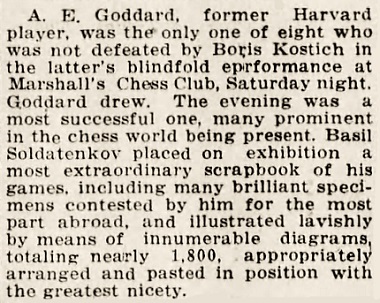
Brooklyn Daily Eagle, 13 February 1919, page 2, Section 1

New York Herald, 17 March 1920, page 11
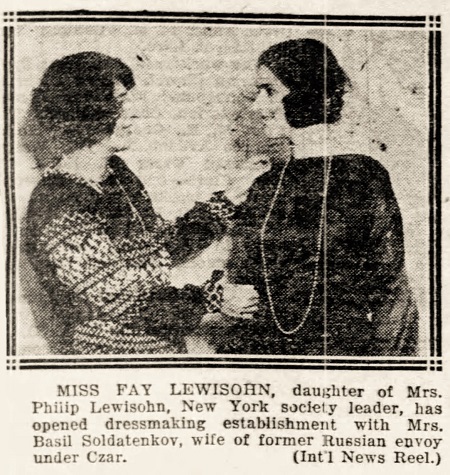
Courier-News (Bridgewater, New Jersey), 12 October 1922
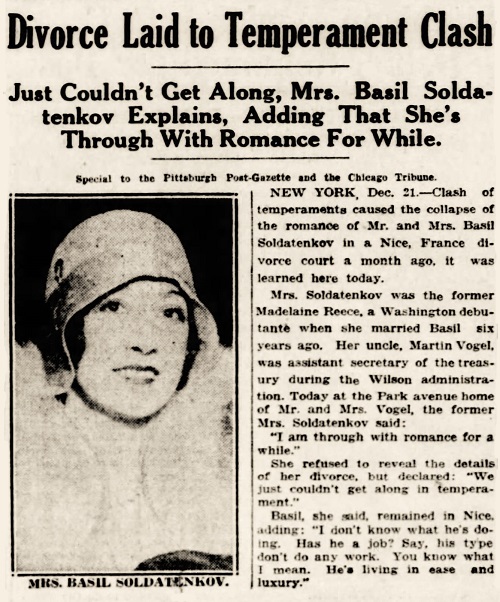
Pittsburgh Post-Gazette, 22 December 1928, page 1.
(10370)
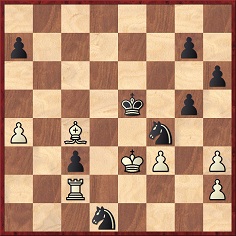
Position after 39...d1(N) mate.
That was the conclusion of a game won by Soldatenkov against C.P. Weeks which has been found by Eduardo Bauzá Mercére (New York, NY, USA) in the Brooklyn Daily Eagle, 24 March 1921, Section 1, page 3:

1 e4 e5 2 Nf3 Nc6 3 d4 exd4 4 Nxd4 Qh4 5 c3 Qxe4+ 6 Be3 Nxd4 7 cxd4 Bb4+ 8 Nc3 Ne7 9 Qd2 Bxc3 10 bxc3 d5 11 f3 Qg6 12 Be2 O-O 13 O-O Bh3 14 Bg5 f6 15 gxh3 Qxg5+ 16 Qxg5 fxg5 17 Rab1 b6 18 Kf2 Rf4 19 Rg1 h6 20 Rg4 Raf8 21 Rxf4 Rxf4 22 Bd3 Kf7 23 Re1 c5 24 dxc5 bxc5 25 Rb1 Ra4 26 Rb2 Ra3 27 Rc2 Kf6 28 Bb5 Ng6 29 Bc6 Nf4 30 Kg3 Rxc3 31 Rd2 Rc1 32 Bd7 c4 33 Kf2 Ke5 34 a4 d4 35 Ra2 d3 36 Ke3 c3 37 Bb5 Rc2 38 Bc4
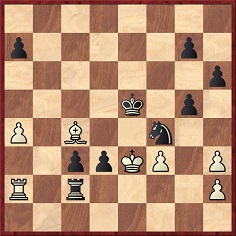
38...d2 39 Rxc2 d1(N) mate.
(10373)
Olimpiu G. Urcan (Singapore) draws attention to a photograph on the webpage of the New York Public Library. The same picture is on a webpage drawn to our attention by Tony Gillam (Nottingham, England), which has the additional statement that Soldatenkov died in Rome on 31 July 1944 (see too the information on a webpage by Denis Orlov).
From Vitaliy Yurchenko (Uhta, Russian Federation):
‘Pages 80-85 of the 12/2018 issue of 64 – Шахматное обозрение have a detailed, illustrated article about V. Soldatenkov by Stanislav Sukhanitsky of Lubny, Ukraine.’
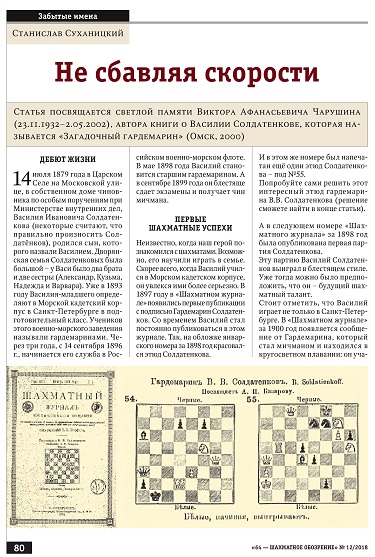
(11154)
To the Chess Notes main page.
To the Archives for other feature articles.
Copyright: Edward Winter. All rights reserved.